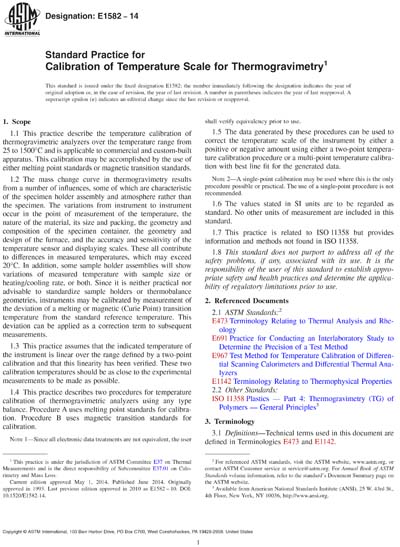Historical
ASTM E1582-14
Standard Practice for Calibration of Temperature Scale for Thermogravimetry
1.1 This practice describe the temperature calibration of thermogravimetric analyzers over the temperature range from 25 to 1500°C and is applicable to commercial and custom-built apparatus. This calibration may be accomplished by the use of either melting point standards or magnetic transition standards.
1.2 The mass change curve in thermogravimetry results from a number of influences, some of which are characteristic of the specimen holder assembly and atmosphere rather than the specimen. The variations from instrument to instrument occur in the point of measurement of the temperature, the nature of the material, its size and packing, the geometry and composition of the specimen container, the geometry and design of the furnace, and the accuracy and sensitivity of the temperature sensor and displaying scales. These all contribute to differences in measured temperatures, which may exceed 20°C. In addition, some sample holder assemblies will show variations of measured temperature with sample size or heating/cooling rate, or both. Since it is neither practical nor advisable to standardize sample holders or thermobalance geometries, instruments may be calibrated by measurement of the deviation of a melting or magnetic (Curie Point) transition temperature from the standard reference temperature. This deviation can be applied as a correction term to subsequent measurements.
1.3 This practice assumes that the indicated temperature of the instrument is linear over the range defined by a two-point calibration and that this linearity has been verified. These two calibration temperatures should be as close to the experimental measurements to be made as possible.
1.4 This practice describes two procedures for temperature calibration of thermogravimetric analyzers using any type balance. Procedure A uses melting point standards for calibration. Procedure B uses magnetic transition standards for calibration.
Note 1: Since all electronic data treatments are not equivalent, the user shall verify equivalency prior to use.
ASTM International [astm]

